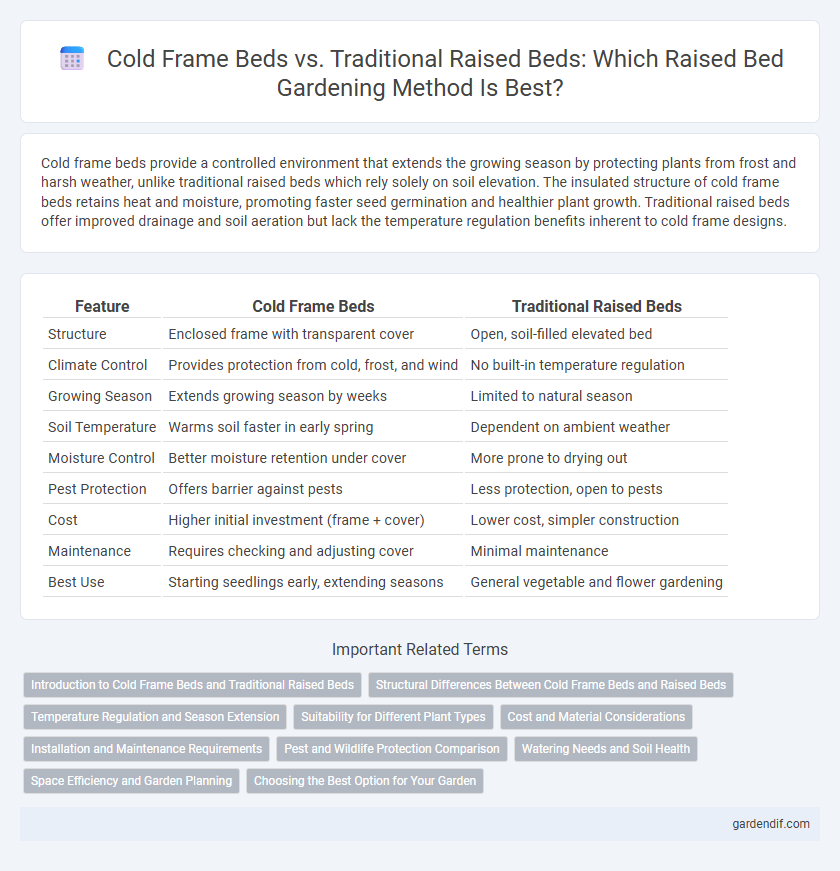
Cold frame beds vs traditional raised beds Illustration
Cold frame beds provide a controlled environment that extends the growing season by protecting plants from frost and harsh weather, unlike traditional raised beds which rely solely on soil elevation. The insulated structure of cold frame beds retains heat and moisture, promoting faster seed germination and healthier plant growth. Traditional raised beds offer improved drainage and soil aeration but lack the temperature regulation benefits inherent to cold frame designs.
Table of Comparison
| Feature | Cold Frame Beds | Traditional Raised Beds |
|---|---|---|
| Structure | Enclosed frame with transparent cover | Open, soil-filled elevated bed |
| Climate Control | Provides protection from cold, frost, and wind | No built-in temperature regulation |
| Growing Season | Extends growing season by weeks | Limited to natural season |
| Soil Temperature | Warms soil faster in early spring | Dependent on ambient weather |
| Moisture Control | Better moisture retention under cover | More prone to drying out |
| Pest Protection | Offers barrier against pests | Less protection, open to pests |
| Cost | Higher initial investment (frame + cover) | Lower cost, simpler construction |
| Maintenance | Requires checking and adjusting cover | Minimal maintenance |
| Best Use | Starting seedlings early, extending seasons | General vegetable and flower gardening |
Introduction to Cold Frame Beds and Traditional Raised Beds
Cold frame beds are enclosed structures with transparent tops that trap solar heat, extending the growing season by protecting plants from frost and harsh weather. Traditional raised beds consist of soil mounded above ground level within framed borders, improving drainage, soil quality, and root development. Both methods enhance plant growth but differ in climate control and protection features, with cold frames providing an effective microclimate for early seedlings and traditional raised beds offering improved soil conditions and accessibility.
Structural Differences Between Cold Frame Beds and Raised Beds
Cold frame beds feature a transparent, hinged lid that traps heat and protects plants from cold weather, contrasting with traditional raised beds, which are open-topped and primarily designed to improve soil drainage and accessibility. The structural framework of cold frames is often lower and enclosed with materials like glass or polycarbonate, while raised beds are typically deeper with open access to soil from above. These differences influence microclimate control, allowing cold frames to extend growing seasons unlike traditional raised beds.
Temperature Regulation and Season Extension
Cold frame beds enhance temperature regulation by trapping solar heat with transparent covers, maintaining warmer soil conditions compared to traditional raised beds. This microclimate allows gardeners to extend the growing season by protecting plants from frost and cold winds. Traditional raised beds lack this insulated environment, making them less effective for early planting or overwintering crops.
Suitability for Different Plant Types
Cold frame beds offer a controlled environment ideal for frost-sensitive plants, seedlings, and early spring vegetables by providing consistent warmth and protection from harsh weather. Traditional raised beds suit a wider variety of plants, including deep-rooted vegetables and perennials, due to their open design that allows greater root expansion and soil aeration. Gardeners often choose cold frame beds for starting plants and extending growing seasons, while traditional raised beds excel in supporting long-term growth of diverse crops.
Cost and Material Considerations
Cold frame beds generally require higher initial investment due to the need for transparent covers, often made from glass or polycarbonate, which can increase costs compared to traditional raised beds composed of wood or composite materials. Traditional raised beds typically use readily available and affordable materials such as cedar, pine, or recycled plastic, offering budget-friendly options without sacrificing durability. Maintenance expenses for cold frame beds may be elevated due to the demand for seasonal cover replacements and potential repairs, whereas traditional raised beds incur minimal upkeep costs over time.
Installation and Maintenance Requirements
Cold frame beds require more complex installation involving transparent covers and ventilation systems to protect plants from cold temperatures while allowing sunlight. Traditional raised beds demand simpler construction using wood or stone frames filled with soil, needing less frequent adjustments. Maintenance for cold frames involves monitoring temperature and humidity closely, whereas traditional raised beds primarily require regular watering and soil replenishment.
Pest and Wildlife Protection Comparison
Cold frame beds offer superior pest and wildlife protection compared to traditional raised beds due to their enclosed design, which acts as a physical barrier against insects, birds, and small mammals. The transparent roof of cold frames helps maintain a controlled microclimate, reducing the need for chemical pesticides and enhancing plant health. Traditional raised beds lack this protective enclosure, making them more vulnerable to damage from wildlife and insect infestations.
Watering Needs and Soil Health
Cold frame beds typically require less frequent watering than traditional raised beds due to their enclosed design, which reduces evaporation and retains moisture more effectively. The consistent microclimate in cold frame beds promotes healthier soil by maintaining stable temperatures and protecting soil microorganisms from harsh weather. In contrast, traditional raised beds are more exposed, leading to quicker soil drying and potentially increased nutrient leaching, which can negatively affect soil health over time.
Space Efficiency and Garden Planning
Cold frame beds maximize space efficiency by combining protection and cultivation in a compact structure, allowing gardeners to extend the growing season and start seedlings earlier compared to traditional raised beds. Their low-profile design integrates seamlessly into garden layouts, optimizing available area and enabling closer plant spacing for intensified garden planning. Traditional raised beds offer more soil volume but require more space and are less adaptable to early-season growth management, making cold frame beds preferable for gardeners with limited space seeking efficient, season-extending solutions.
Choosing the Best Option for Your Garden
Cold frame beds offer enhanced temperature control and extended growing seasons by trapping solar energy, making them ideal for gardeners in cooler climates. Traditional raised beds provide excellent soil drainage and accessibility, suitable for a wide range of plants and easier installation. Selecting between cold frame and raised beds depends on your local climate, crop needs, and desired season length for optimal garden productivity.
Cold frame beds vs traditional raised beds Infographic

 gardendif.com
gardendif.com